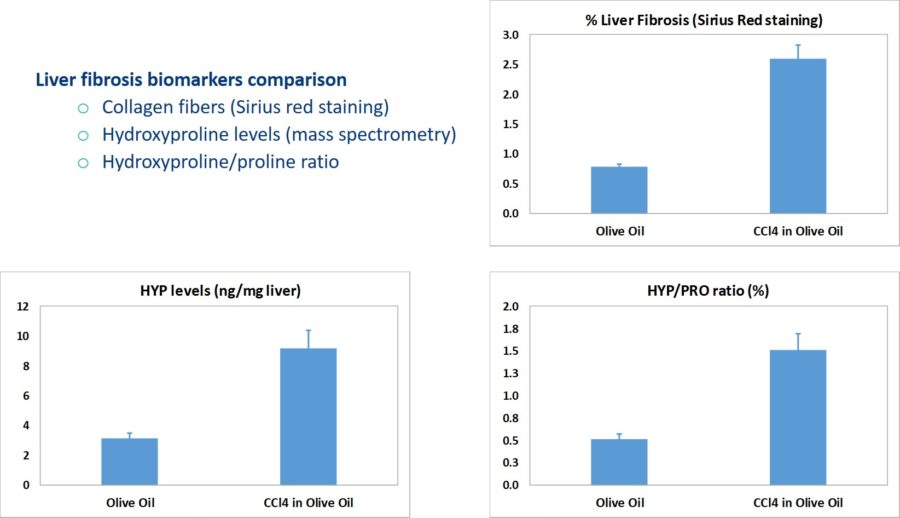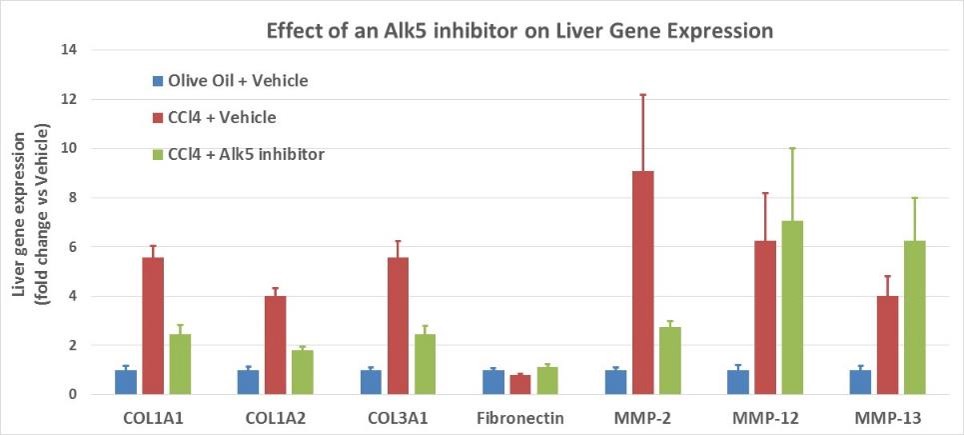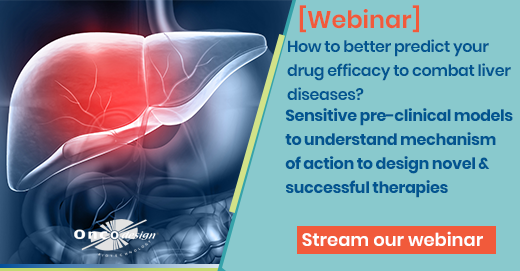


Preclinical CRO Services for Inflammatory Diseases of the Liver
Acute and chronic inflammatory diseases of the liver tract can be triggered by several causes such as exposure to toxic chemicals, diet or immune dysregulation. Rodent models of liver inflammation are helpful to decipher the disease triggering or sustaining mechanisms observed in patients.
Oncodesign Services offers CRO services for several preclinical models addressing a variety of liver diseases, and provides CRO support for de novo development of new research models recently described in literature
Typical readouts in liver inflammation
- Steatosis
- Fibrosis
- NASH score
- Neutrophil infiltration
- Serum markers of liver injury: LDH, ALT, AST
- Inflammation markers
- Immune cell infiltrates
- Ballooning degeneration of hepatocytes
- Apoptosis markers or necrotic histology
- Gene expression in liver, by qPCR/dPCR
- Biomarker / drug monitoring
Discover Oncodesign Services offers for liver inflammation diseases
-
Acute liver injury models in mice (1)
- FasL, Acetaminophen
-
Chronic liver injury models in mice (2)
- CCl4 fibrosis
- STZ+HFD NASH
- CCl4+HFD NASH
- Long term NASHHCC

Case studies in liver inflammation
The CCl4 model of liver fibrosis is a classic model widely used in industry. Juvenile mice are given repeated doses of CCl4.Liver fibrosis then typically appears at 6 weeks old.
This model is useful for therapies aiming to modulate collagen depositions and expression of metalloproteases. ALK5 (TGFb receptor I) inhibition, a well-known anti-fibrotic mechanism, decreases collagen induction and is used as a reference compound.


-
References
(1) Acute liver injury models in mice
FasL:
Shao R, Yang Y, Fan K, Wu X, Jiang R, Tang L, Li L, Shen Y, Liu G, Zhang L. REV-ERBα Agonist GSK4112 attenuates Fas-induced Acute Hepatic Damage in Mice. Int J Med Sci. 2021 Oct 25;18(16):3831-3838. doi: 10.7150/ijms.52011. PMID: 34790059; PMCID: PMC8579287. https://www.medsci.org/v18p3831.htm
Ogasawara J, Watanabe-Fukunaga R, Adachi M, Matsuzawa A, Kasugai T, Kitamura Y, Itoh N, Suda T, Nagata S. Lethal effect of the anti-Fas antibody in mice. Nature. 1993 Aug 26;364(6440):806-9. doi: 10.1038/364806a0. Erratum in: Nature 1993 Oct 7;365(6446):568. PMID: 7689176 https://www.nature.com/articles/364806a0
Lesnikov V, Gorden N, Fausto N, Spaulding E, Campbell J, Shulman H, Fleming RE, Deeg HJ. Transferrin fails to provide protection against Fas-induced hepatic injury in mice with deletion of functional transferrin-receptor type 2. Apoptosis. 2008 Aug;13(8):1005-12. doi: 10.1007/s10495-008-0233-6. PMID: 18561026; PMCID: PMC2574612. https://link.springer.com/article/10.1007/s10495-008-0233-6
Ohtaki Y, Yamaguchi K, Yu Z, Kumamoto H, Shimauchi H, Iwakura Y, Sugawara S, Endo Y. Hepatic platelet accumulation in Fas-mediated hepatitis in mice. Int Immunopharmacol. 2009 Aug;9(9):1071-8. doi: 10.1016/j.intimp.2009.04.016. Epub 2009 May 9. PMID: 19439197. https://www.sciencedirect.com/science/article/pii/S1567576909001659?via%3Dihub
Donthamsetty S, Mars WM, Orr A, Wu C, Michalopoulos GK. Protection against Fas-induced fulminant hepatic failure in liver specific integrin linked kinase knockout mice. Comp Hepatol. 2011 Nov 21;10:11. doi: 10.1186/1476-5926-10-11. PMID: 22104495; PMCID: PMC3228663. https://www.ncbi.nlm.nih.gov/pmc/articles/PMC3228663/
Acetaminophen:
- Mechanism:
Ni HM, McGill MR, Chao X, Du K, Williams JA, Xie Y, Jaeschke H, Ding WX. Removal of acetaminophen protein adducts by autophagy protects against acetaminophen-induced liver injury in mice. J Hepatol. 2016 Aug;65(2):354-62. doi: 10.1016/j.jhep.2016.04.025. Epub 2016 May 2. PMID: 27151180; PMCID: PMC4955750. https://www.journal-of-hepatology.eu/article/S0168-8278(16)30169-6/fulltext
Groeneveld D, Cline-Fedewa H, Baker KS, Williams KJ, Roth RA, Mittermeier K, Lisman T, Palumbo JS, Luyendyk JP. Von Willebrand factor delays liver repair after acetaminophen-induced acute liver injury in mice. J Hepatol. 2020 Jan;72(1):146-155. doi: 10.1016/j.jhep.2019.09.030. Epub 2019 Oct 10. PMID: 31606553; PMCID: PMC6941657. https://www.journal-of-hepatology.eu/article/S0168-8278(19)30600-2/fulltext
- Review:
Mossanen JC, Tacke F. Acetaminophen-induced acute liver injury in mice. Lab Anim. 2015 Apr;49(1 Suppl):30-6. doi: 10.1177/0023677215570992. PMID: 25835736. https://journals.sagepub.com/doi/10.1177/0023677215570992?url_ver=Z39.88-2003&rfr_id=ori:rid:crossref.org&rfr_dat=cr_pub%20%200pubmed
osner I, Romero-Ferret C, Mottot G. Letter: Treatment of acute paracetamol poisoning. Lancet. 1973 Dec 1;2(7840):1273-4. doi: 10.1016/s0140-6736(73)91024-6. PMID: 4128608 https://www.thelancet.com/journals/lancet/article/PIIS0140-6736(73)91024-6/fulltext
- Testing compounds :
Jaeschke H, Akakpo JY, Umbaugh DS, Ramachandran A. Novel Therapeutic Approaches Against Acetaminophen-induced Liver Injury and Acute Liver Failure. Toxicol Sci. 2020 Apr 1;174(2):159-167. doi: 10.1093/toxsci/kfaa002. PMID: 31926003; PMCID: PMC7098369. https://academic.oup.com/toxsci/article/174/2/159/5700748?login=false
Niu B, Lei X, Xu Q, Ju Y, Xu D, Mao L, Li J, Zheng Y, Sun N, Zhang X, Mao Y, Li X. Protecting mitochondria via inhibiting VDAC1 oligomerization alleviates ferroptosis in acetaminophen-induced acute liver injury. Cell Biol Toxicol. 2022 Jun;38(3):505-530. doi: 10.1007/s10565-021-09624-x. Epub 2021 Aug 17. PMID: 34401974. https://link.springer.com/article/10.1007/s10565-021-09624-x
- Role of microbiota:
Schneider KM, Elfers C, Ghallab A, Schneider CV, Galvez EJC, Mohs A, Gui W, Candels LS, Wirtz TH, Zuehlke S, Spiteller M, Myllys M, Roulet A, Ouzerdine A, Lelouvier B, Kilic K, Liao L, Nier A, Latz E, Bergheim I, Thaiss CA, Hengstler JG, Strowig T, Trautwein C. Intestinal Dysbiosis Amplifies Acetaminophen-Induced Acute Liver Injury. Cell Mol Gastroenterol Hepatol. 2021;11(4):909-933. doi: 10.1016/j.jcmgh.2020.11.002. Epub 2020 Nov 12. PMID: 33189892; PMCID: PMC7900526 https://www.cmghjournal.org/article/S2352-345X(20)30181-8/fulltext
(2) Chronic liver injury models in mice
- Review :
Ravichandra A, Schwabe RF. Mouse Models of Liver Fibrosis. Methods Mol Biol. 2021;2299:339-356. doi: 10.1007/978-1-0716-1382-5_23. PMID: 34028753. https://link.springer.com/protocol/10.1007/978-1-0716-1382-5_23
- CCl4 fibrosis
Scholten D, Trebicka J, Liedtke C, Weiskirchen R. The carbon tetrachloride model in mice. Lab Anim. 2015 Apr;49(1 Suppl):4-11. doi: 10.1177/0023677215571192. PMID: 25835733.
Chang J, Lan T, Li C, Ji X, Zheng L, Gou H, Ou Y, Wu T, Qi C, Zhang Q, Li J, Gu Q, Wen D, Cao L, Qiao L, Ding Y, Wang L. Activation of Slit2-Robo1 signaling promotes liver fibrosis. J Hepatol. 2015 Dec;63(6):1413-20. doi: 10.1016/j.jhep.2015.07.033. Epub 2015 Aug 8. PMID: 26264936. https://www.journal-of-hepatology.eu/article/S0168-8278(15)00536-X/fulltext
Arroyo N, Villamayor L, Díaz I, Carmona R, Ramos-Rodríguez M, Muñoz-Chápuli R, Pasquali L, Toscano MG, Martín F, Cano DA, Rojas A. GATA4 induces liver fibrosis regression by deactivating hepatic stellate cells. JCI Insight. 2021 Dec 8;6(23):e150059. doi: 10.1172/jci.insight.150059. PMID: 34699385; PMCID: PMC8675192. https://insight.jci.org/articles/view/150059
Shrestha N, Chand L, Han MK, Lee SO, Kim CY, Jeong YJ. Glutamine inhibits CCl4 induced liver fibrosis in mice and TGF-β1 mediated epithelial-mesenchymal transition in mouse hepatocytes. Food Chem Toxicol. 2016 Jul;93:129-37. doi: 10.1016/j.fct.2016.04.024. Epub 2016 Apr 29. PMID: 27137983. https://www.sciencedirect.com/science/article/abs/pii/S0278691516301302?via%3Dihub
Wu H, Chen G, Wang J, Deng M, Yuan F, Gong J. TIM-4 interference in Kupffer cells against CCL4-induced liver fibrosis by mediating Akt1/Mitophagy signalling pathway. Cell Prolif. 2020 Jan;53(1):e12731. doi: 10.1111/cpr.12731. Epub 2019 Nov 22. PMID: 31755616; PMCID: PMC6985653. https://onlinelibrary.wiley.com/doi/10.1111/cpr.12731
- NASH MODELS : STZ+HFD NASH / CCl4+HFD NASH / Long term NASH-HCC
Hansen HH, Feigh M, Veidal SS, Rigbolt KT, Vrang N, Fosgerau K. Mouse models of nonalcoholic steatohepatitis in preclinical drug development. Drug Discov Today. 2017 Nov;22(11):1707-1718. doi: 10.1016/j.drudis.2017.06.007. Epub 2017 Jul 4. PMID: 28687459 https://www.sciencedirect.com/science/article/pii/S1359644617300272?via%3Dihub
Lefebvre E, Moyle G, Reshef R, Richman LP, Thompson M, Hong F, Chou HL, Hashiguchi T, Plato C, Poulin D, Richards T, Yoneyama H, Jenkins H, Wolfgang G, Friedman SL. Antifibrotic Effects of the Dual CCR2/CCR5 Antagonist Cenicriviroc in Animal Models of Liver and Kidney Fibrosis. PLoS One. 2016 Jun 27;11(6):e0158156. doi: 10.1371/journal.pone.0158156. PMID: 27347680; PMCID: PMC4922569. https://journals.plos.org/plosone/article?id=10.1371/journal.pone.0158156
Klein T, Fujii M, Sandel J, Shibazaki Y, Wakamatsu K, Mark M, Yoneyama H. Linagliptin alleviates hepatic steatosis and inflammation in a mouse model of non-alcoholic steatohepatitis. Med Mol Morphol. 2014 Sep;47(3):137-49. doi: 10.1007/s00795-013-0053-9. Epub 2013 Sep 19. PMID: 24048504. https://link.springer.com/article/10.1007/s00795-013-0053-9
Orime K, Shirakawa J, Togashi Y, Tajima K, Inoue H, Nagashima Y, Terauchi Y. Lipid-lowering agents inhibit hepatic steatosis in a non-alcoholic steatohepatitis-derived hepatocellular carcinoma mouse model. Eur J Pharmacol. 2016 Feb 5;772:22-32. doi: 10.1016/j.ejphar.2015.12.043. Epub 2015 Dec 24. PMID: 26724391. https://www.sciencedirect.com/science/article/abs/pii/S0014299915304398


